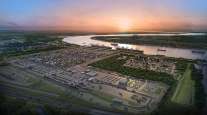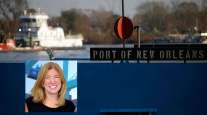Port of New Orleans Looks Ahead to a Decade of Growth in Cargo, Cruise Businesses

As it charts a course for at least the next decade, the Port of New Orleans is weighing nearly $2 billion worth of potential projects to support its growing cargo, rail, cruise ship and industrial real estate businesses.
The plans, which are outlined in the port’s newly released master plan, are largely conceptual but, if completed, could reshape the region’s maritime sector, officials say.
About half of the $2 billion total is related to a proposed $1 billion-plus container cargo terminal and logistics center that is under consideration for an undeveloped, 675-acre tract of land in St. Bernard Parish.
RELATED: Kansas City Southern adds rail service between Port of New Orleans, Dallas
Port officials say the proposed Meraux development would create thousands of jobs and help lift St. Bernard’s long-stagnant economy.
The concept of the development was unveiled in 2018, and officials are studying whether the site, which is zoned for heavy industrial activity, could support a riverside container terminal and distribution complex. An initial evaluation could be completed by the beginning of 2019.

It has been a decade since the port released its last master plan. Since then, its circumstances — and those of the city — have shifted from post-Hurricane Katrina recovery to planning ahead for expected growth.
The 2008 master plan outlined $1 billion in potential projects, including a multiphase, estimated $500 million plan to expand the Napoleon Avenue Container Terminal, which would have increased its annual capacity to more than 1.6 million industry standard 20-foot equivalent units — a measure of cargo capacity for containerized shipping — or nearly 50% more than it can handle today.
Those plans also were drafted to account for the effects of the multibillion-dollar widening of the Panama Canal, which was completed in 2016, allowing larger cargo ships to go through the canal.
However, after the plan was released in the wake of the 2008-10 financial crisis, the port’s biggest obstacle proved to be getting the money to do the proposed expansions.
The port released its new master plan late last month after nearly two years of meetings with customers, local officials and the public. The 96-page document provides a general road map for the port’s projected growth as it works to increase its share of the global shipping market.
The report provides an analysis of the port’s cargo, cruise and real estate businesses and lays out ideas for optimizing its current facilities, including the recently acquired Public Belt Railroad. It highlights ways of increasing capacity for break-bulk and container cargo, and finding ways to revitalize underused industrial real estate near the Industrial Canal and along the Mississippi River, including in Jefferson and St. Bernard parishes.
The port’s governing board is scheduled to consider adopting the plan May 24.
Port President and CEO Brandy Christian said the planning process will help shape the port’s growth as well as extend its reach into surrounding parishes. By expanding elsewhere, it could drum up new economic opportunities there and respond to officials who in recent years have urged the New Orleans port to give their parishes a look.
“We wanted something that went beyond just looking at what facilities, what’s the next terminal, that we build to largely developing economic development strategies for the region and the port complex,” Christian said.

Christian
Over the next four to five years, the plan calls for spending about $365 million on capital projects intended to improve efficiency, expand capacity and address maintenance issues at port facilities, wharves and bridges.
To do so, the port anticipates it will need a mix of state and federal money, as well as public-private partnerships and joint ventures. Port officials also hope to catch the eye of those planning President Donald Trump’s proposed $1.5 trillion infrastructure spending plan.
The near-term projects that are ready to go if funding is available include $113 million worth of general infrastructure projects, including replacing the Almonaster Avenue Bridge and repairing the substructure at the Poland Avenue Wharf.
About $109 million worth of container-related projects are listed, including adding new 100-foot gauge container cranes, which are equipped to service wider, Neopanamax vessels, and paving the marshaling yard at the Napoleon Avenue terminal.
Making improvements to the break-bulk terminals at First Street and Harmony and Seventh streets also are included, as well as repairing the Jourdan Road Wharf, which together accounts for about $85 million.
As for its industrial real estate, the port’s proposed short-term projects tally about $37 million. They include making security and road improvements along the Industrial Canal and improving and rebuilding France, Jourdan and Terminal roads.
To accommodate the city’s growing cruise business, plans call for spending about $8 million on making improvements at the Erato and Julia Street terminals and identifying the site for a new cruise terminal, which has long been eyed for Poland Avenue. Although that site is still up for debate, any future terminal will have to be situated at a deep-draft wharf that is downriver of the Crescent City Connection.
The port forecasts that it could justify adding another cruise terminal in the next decade, a timeline that could be accelerated if a cruise line is willing to commit the cash for the terminal, officials say.
Cargo
The port’s Napoleon Avenue container facility is gradually nearing its cargo-handling capacity. It handled more than a half-million TEUs in the 2017 fiscal year, which ended last June.
That tally is expected to rise, with some experts predicting hundreds of thousands of additional TEUs will flow through the Gulf region in the next two years, in large part driven by Louisiana-produced resins.
Napoleon Avenue’s capacity is approximately 840,000 TEUs, but it can be built out to accommodate about 1.5 million. That would involve upgrading to larger cranes and maximizing space in its existing yards — steps that are included in the master plan.
Cruise ships
Similarly, the local port’s cruise ship business is growing: A record 1.2 million passengers traveled through the port in 2017, a number that was lifted by the city’s booming tourist industry, which surpassed 11 million visitors last year. It was the fourth consecutive year of topping the 1 million-passenger mark.
The @CelebrityCruise Equinox makes #PortNOLA a port of call today. pic.twitter.com/61axn2BNXj — Port of New Orleans (@PortNOLA) April 27, 2018
Based on projected industry growth, port officials continue to evaluate building a third cruise ship terminal. Average annual growth in passengers between 2010 and 2017 hit nearly 5%, with about 225 cruise ship calls in 2016.
In turn, officials expect oceangoing cruise passenger growth will rise to upward of 1.3 million passengers in 2020 and potentially 1.9 million by 2030, depending on different scenarios.
For decades, the Poland Avenue Wharf, which now serves as an overflow area for break-bulk cargo and cruise ships that are making brief port calls, has been considered the likeliest location for a new cruise ship terminal. In fact, the port identified it that way in its 2008 plan. But the idea has faced some opposition from neighbors, and the port still is evaluating alternative locations.
Already, the port is spending about $20 million on maintenance and repairs at Poland Avenue, but a new cruise terminal likely would cost about $50 million.
Real estate
The port also is evaluating how to spruce up its real estate along the Industrial Canal to help draw tenants, particularly those interested in developing value-added businesses. The port plans to invest in the infrastructure — roadways, utilities, landscaping — to create an industrial park-type atmosphere that could attract market-rate tenants.
Developing properties in that area, which is served by rail lines and accessible to the Gulf Intracoastal Waterway, could be a boon for the local maritime industry, port officials said. The port owns about 1,000 acres of potentially developable industrial property near the 5.5-mile waterway.

Landry
“The need is there. I think the demand for the property is there. There just hasn’t been the investment,” said Robert Landry, the New Orleans port’s vice president of commercial operations.
The port also is expected to benefit from efforts to finally redevelop the former Avondale shipyard on the Mississippi River into an intermodal terminal. Though nothing is final, advanced talks are underway for the 206-acre Avondale site to be purchased by a new partnership that includes Hilco Global, an Illinois-based financial services firm that often is hired to help liquidate bankrupt companies, and T. Parker Host Inc., a Virginia-based shipping agent.
The idle west bank facility features more than 7,900 feet of riverfront access and offers users deepwater access.
From the list of projects, Christian described the planned upgrades at Napoleon Avenue as the port’s “most pressing investments, not only to stay in the market, but to grow the market.”
“Looking at a second container terminal [in St. Bernard] is really to anticipate looking out 10-plus years to where the market could be,” she added.
Basically, the port will look at things “project by project” but so far has received positive interest, particularly from customers who may be asked to contribute to offset much of the cost of the various projects.
“We are in a unique position because we have the rail connectivity and the water connectivity of an intramodal shipping port,” Christian said, “and we really just want to expand our reach along the Mississippi River.”
Distributed by Tribune Content Agency, LLC




